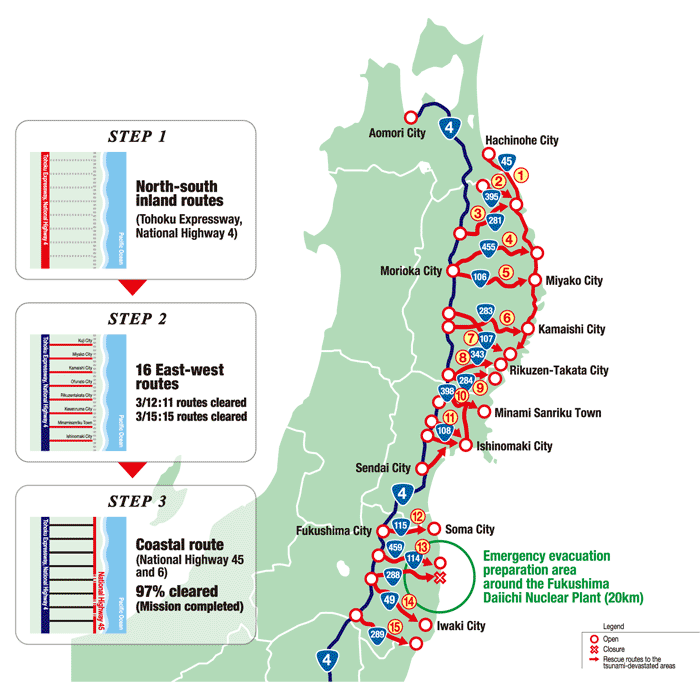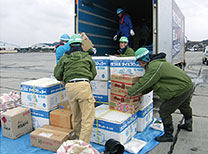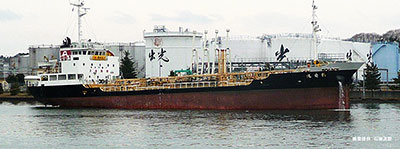Parts of national highway along Pacific Ocean coast were affected by the massive earthquake and tsunami resulting in some routes getting blocked. Rescuing victims from isolation asap was of vital importance. Operation [Teeth of a Comb] to secure a [Road of Life] to the disaster area was launched immediately. The many roads, stretching like comb’s teeth from Tohoku expressway and route 4 to the coastal area, were secured and the battle against time had begun. Brave rescuers worked day and night to save the injured and transport relief supplies.
ASAP Securing a rescue and relief route
Scramble 37 minutes after the earthquake.
Live coverage from the rescue helicopter helped make decisions of early responses.
The massive tsunami engulfed Sendai Airport; but just before that, a rescue helicopter “Michinoku” of the MLIT Tohoku Regional Bureau took off from the airport. The crew members of an airline company, immediately after the earthquake, cut the broken shutter of the hangar and prepared for takeoff. The helicopter took off from the airport by the order from the MLIT Tohoku Regional Bureau 37 minutes after the earthquake.
The helicopter broadcasted almost inconceivably huge tsunami and sent shocking image of massive destruction live. This firsthand information helped prioritize the initial response: priority should be given to securing a rescue and relief route.

the rescue helicopter “Michinoku”
2011.3.11 PM 3:23
Source: the MLIT Tohoku Regional Bureau

2011.3.11 PM 4:17
Source: the MLIT Tohoku Regional Bureau
Operation “Teeth of a Comb” was carried out.
A mission to clear the Road of Life. No moment to lose.

Operation “Teeth of a Comb” was a road clearance operation to secure rescue and relief routes on a number of national highways extending from inland toward the Pacific coastal area of Tohoku. The operation was named after the shape of the road network under Operation, where the Tohoku Expressway and Route 4 run inland Tohoku from north to south, and a number of debris-covered roads to be cleared extend from the expressway and Route 4 toward the coast.
The inconceivably huge tsunami devastated the areas along the Pacific coast of Tohoku, leaving many areas isolated by debris-covered roads and swept bridges. Immediately after the earthquake, the Bureau leaders and staff gathered in the Disaster Risk Management Office of the MLIT Tohoku Regional Bureau.
Communication with the road and highway offices and braches was established soon to gather information on the damage, and the strategy had been worked out. Operation “Teeth of a Comb” was immediately carried out to clear the roads and secure the Road of Life.
11 routes were secured in two days.
We cleared debris from the roads, removed bumps, and secured rescue and relief routes.

Rikuzentakata, Iwate
Source: the MLIT Tohoku Regional Bureau
Secure routes to save lives of many injured people, and to deliver relief supplies to the disaster-affected people.
Under Operation “Teeth of a Comb” that was worked out immediately after the earthquake, the “road clearance” works were carried out. What are the road clearance works? They clear debris or other obstructions from the road.
The prefectural office staff, the members of the JSDF, the workers of local construction companies, and the MLIT Tohoku Regional Bureau staff - they worked as a team, and pushed their way through the debris. In the midst of fear of aftershocks and tsunami warnings, they dedicated themselves to the work, just “hoping to save as many lives as possible”. On the March 12, the following day of the earthquake, 11 routes were secured; then, 15 routes on March 15, allowing emergency traffic, including ambulances, the police, and the JSDF.
Medical teams were also able to reach the affected areas. Relief supplies were delivered to where needed.
Levees became emergency transportation routes.
Priority of restoration works was given to the river road levees, which facilitated transportation of emergency relief supplies.
Thousand hundred meters of the river road levee was swept away in the mouth of the Kitakamigawa River (Kamaya area, Ishinomaki).
As a result, some villages were isolated, and rescue operations were suspended.
Priority of restoration works were given to the works to secure a space just wide enough for a car to get through. On March 14, temporary one-lane traffic was restored.
This has facilitated traffic of emergency vehicles and transportation of emergency relief supplies, leading to greater support to the affected areas.
Restoration of similarly affected river road levees was also undertaken, while priority was given to the restoration of traffic.



Interim mutual usage of a single lane 2011.3.14
Pumper trucks, drainage volume 5 million m3.
To immediate restoration, concentrated effort to gather pumper trucks to Sendai Airport and the surrounding areas.
The Tohoku’s all important air entrance, Sendai Airport, was also attacked by the massive tsunami. The 2nd floor of the airport facilities were flooded with the 1st floor being completely destroyed. A vast area of the airport towards the coast was also flooded and suffered significant damage. To restore the airport the MLIT Tohoku Regional Bureau gathered pumper trucks from all over Japan. From the 24th of March 25 pumper trucks were working day and night. Later there were over 250 trucks pumping in total, as much as 5 million ㎥ of water a day which is equivalent to about 14 thousand 25m pools. Almost a month later from the disaster, on the 13th of April the airport was partially restored resuming special flights.

Devastated Sendai Airport 2011.3.13

Sendai Airport/Drainage operation start 2011.3.17

Sendai Airport is nearing restoration 2011.3.24
By March 23, ten major ports became accessible.
Channel clearance, which was to remove obstructions in the harbors, began three days after the earthquake.

(clearing sunken containers)

(clearing sunken cars)

(clearing washed away wood debris)
After the tsunami warning and advisory were lifted in the evening of March 13, channel clearance, which was to remove containers, cars, fishnets, etc. drifted from shore or sunk in the sea, began from early morning of March 14.
Priority of channel clearance works was given to the Port of Miyako, Kamaishi, and Sendai-Shiogama, the biggest port in Tohoku, because transportation of relief supplies was considered the most important. Clearance works were later expanded to include others major ports. On March 16, the fifth day after the earthquake, a ship with emergency relief supplies on board entered the Port of Kamaishi. By March 23, temporary safe channel had been secured in ten affected ports, allowing the ports to receive emergency relief supplies by marine transportation.
On March 21, the tenth day after the earthquake, the first oil tanker entered the Port of Sendai-Shiogama, relieving the shortage of fuel oil.

Port of Miyako, Iwate 2011.3.16

The number of ships entering the ports between March 21 and 31

Port of Sendai-Shiogama, Miyagi 2011.3.21
| March 21 - 26 2,000 kl class tanker 8 |
Fuel oil about 16,000 kl |
| March 27 - 31 5,000 kl class tanker 12 |
Fuel oil about 37,000 kl |
| Total | about 53,000 kl |
| Miyagi Prefecture’s daily fuel expenditure (about 3,700〜4,500kl of gasoline) | |
